One of the first thoughts I had upon rolling through the gate at Devils Tower was that Teddy certainly got it right when he used the Antiquities Act to designate this tall stump of rock as America’s first national monument.
If I could be sure that it would always be this way, I think I could live forever in the campground at Devils Tower here in northeastern Wyoming and be perfectly happy. This day contained blue sky dotted with a few spongy, fair weather cumulus clouds, a gentle breeze, and no biting flies. It’s uncrowded, too. A quiet oasis that apparently rarely fills to its small capacity save for a week or so when the Harleys gather in early August at nearby Sturgis, South Dakota.
Yet this seemingly tranquil little patch of peacefulness is still being hit by the record numbers of visitors who are engulfing other parks this summer. One ranger told me they are running about 3,000 visitors a day through their very small visitor center – and they know that only a fraction of all visitors who roll through the entrance station wind up inside the VC.
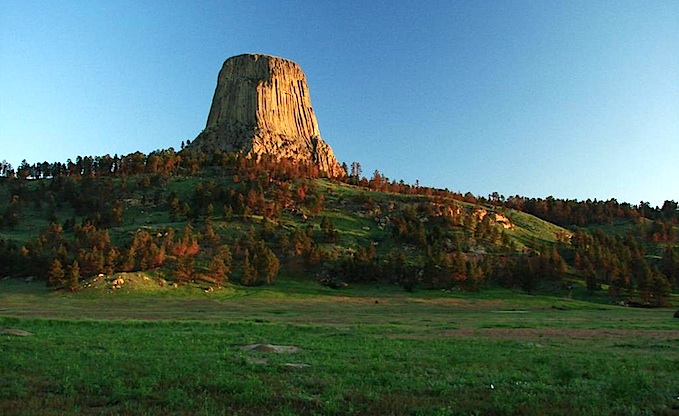
Devils Tower, America's first national monument. Lee Dalton photo.
And so I was amazed when I called to see what time Devils Tower's campground fills only to be told, “Hardly ever.” I remember times 20 years ago when we had to arrive early and almost fight for a spot. What’s making the difference?
Perhaps a couple of rangers at two different parks provided some clues. Here at Devils Tower the small campground cannot handle "big rigs." Huge behemoth trailers and monster RV wagons can’t negotiate the site spurs. A night or two earlier, a Wyoming state park ranger offered another explanation when I congratulated him on his peaceful and well-kept camp just alongside a main highway to and from Yellowstone National Park outside of Cody.
“You’d be amazed,” he said, “how many people pull up to our entrance station and ask if we have electricity. When we tell them we don’t, they turn around and leave.”
“Ah, ha!” thought I. The American obsession with luxury just might actually be helping to preserve peaceful places for the rest of us.
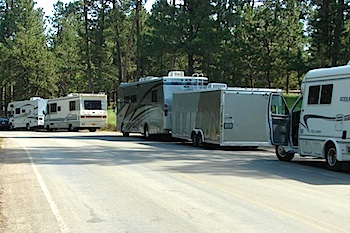
Big and long RVs can't quite fit into Devils Tower's campground. Lee Dalton photo.
But even so, the crush of increasing traffic in a place like Devils Tower is choking it. When I drove past the picnic area the first time, I was struck by the sheer size of it. Then the next afternoon I wandered past around lunchtime and it was completely jammed with a few people sitting on the grass enjoying the shade it offers.
Small Park, Big Impact
Devils Tower is a small place. Only 1,300 acres. The tower itself occupies only a few of those. The rest is a stunning collection of grassland (greener than usual this year) and ponderosa pine forest.
The campground is meadow shaded by large, old cottonwood trees set along the Belle Fouche River. It has two loops and a total of 42 widely spaced sites shaded by big and elderly cottonwoods. I’d like to go shake somebody’s hand for a sign I saw in the camp. It advises that trees in the campground are old, and limbs may break from time to time. But instead of cutting down the trees, the park advises campers to “Be very careful where you park your car or camper or pitch your tent.” Much better than cutting the trees when shade is already a bit scarce.
The visitor center is a very small, bare-bones log building that was built by the Civilian Conservation Corps way back in the olden days. Its exhibits are simple and to the point. Probably a good thing, considering the idea that something like 3,000 people a day are trying to pass through there.
There’s a small bookstore run by the Devils Tower History Association, an independent cooperating association. There may be some very good advantages to being independent and not so mired in the political gamesmanship that seems to have infected some of the larger associations. On the other hand, they can’t provide big ticket donations to the monument.
Parking is at a premium up there. They’ve had to blaze some gravel roads and pads among the trees to accommodate the daily overflow. I learned later that the overflow parking is actually a resurrection of an old campground. Large vehicles clog the entry road as they park alongside. There is a small parking lot near the administration building where visitors may leave trailers, but it’s apparent very few do it.
It struck me that with its narrow and winding mountain road, Devils Tower would be a perfect place for a shuttle system.
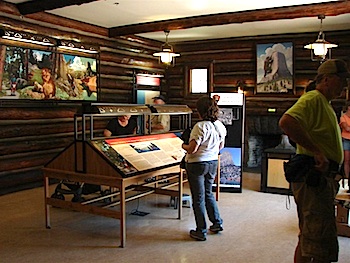
The visitor center is small, but accommodating. Lee Dalton photo.
When I asked about that at the administration building, I got the same old answer that destroys so many ideas that might improve our parks.
“A shuttle? We’re always talking about a shuttle. Just one problem. Where will the money come from?”
Indeed, where will it?
I just hope, very sincerely, that we will always find the courage to stand firm against demands that are sure to come as various groups press for more parking and camping places for a fleet of future vehicles of ever increasing size and luxury. Shouldn’t there be a limit somewhere?
Sequestration Impacts
I asked about effects of sequestration and was told that although it has hurt, it has not been unmanageable. Devils Tower has two permanent and two seasonal law enforcement rangers, down one because they were able to consolidate their climbing ranger with a law enforcement job. There are only five interpretive rangers, counting permanent and seasonal positions. The maintenance staff is generally four, with a number of other slots filled as various projects come and go. An example of that is the crew battling invasive plant species in an operation funded by a variety of sources with only about 20 percent coming from the park’s operating funds.
Law enforcement is a very small problem here except for the week of the huge motorcycle rally in nearby Sturgis. Additional rangers are brought in for that and help is available from local law enforcement – and occasionally NPS rangers go to assist the sheriff and his deputies.
Search and rescue is a surprisingly small part of Devils Tower's operation. When a rescue from the boulder field requires more help, the local fire department and search-and-rescue organization moves in to assist. Relations with the local communities are great and beneficial to all parties.
About the only effect I could see for other visitors were the three nights a week when there is no evening ranger program. But, like the reduction of programs in Yellowstone, it’s probably not something that will be noticed by the average visitor. Otherwise, the park seems to be in great shape. Restrooms and trails are immaculate. Capable volunteers handle campground operations and Devils Tower History Association provides at least one “contract interpreter.”
I found myself sitting at the base of the tower along the trail below a jumble of huge boulders. People clambered and scrambled over the rocks up to the very base of the huge monolith. It was fun listening to a choir of different languages and watching as people of all shapes, sizes and ages each found their own ways to experience the park. I watched a couple of Japanese teenagers trying to decide if two empty water bottles should go into the Plastic or Aluminum hole in a recycling bin. They finally decide to play it safe and put one bottle in each of the two holes.
About 5,000 climbers come to find their way up Devils Tower every year.
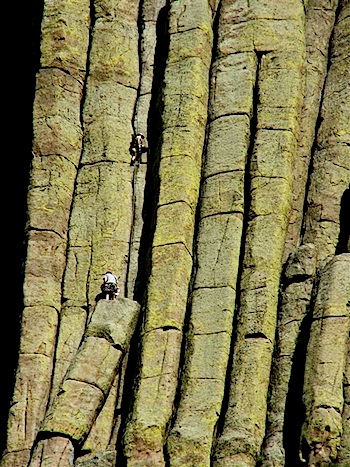
Some 200 climbing routes exist on Devils Tower. Lee Dalton photo.
There are over 200 identified routes to the top. Unbelievable as it may seem, one young man scaled the tower in about 16 minutes!
June has special spiritual significance for many Native Americans who revere this as a special place – so climbers are asked to voluntarily refrain from climbing in June. Happily, most climbers do so.
Native American Influences
Near the picnic area and campground is a large white sculpture that immediately made me think of a smoke ring. When I walked out to see it, I found that is exactly what it is.
The Circle of Sacred Smoke represents the smoke from a Native American pipe. Sculpted by Japanese artist Junkyu Muto, it serves as a reminder of the sacred nature of this place in the cultures of 20 or more tribes of plains Indians.
I was struck by its representation of infinity as its surfaces twist into a mobius shape. It may be a bit unusual to find a sculpture in a natural area like Devils Tower, but this one fits perfectly. I learned later that the sculptor donated it to this place. It is one of three identical sculptures he has donated to places he felt were of great spirituality. One is located in Bodh Gaya, India, where Buddha found enlightenment, and the other is at the Vatican in Rome.
Signs along the trails around the tower remind visitors that to many people, this is a sacred place. We are asked not to disturb prayer bundles and cloths left beside the trail by our Native neighbors. To those who leave them, this is a cathedral.
Early one morning I walked from the campground to the Sacred Smoke sculpture and sat in silence with only morning bird songs surrounding me. I’m not particularly religious, but as I sat there alone looking up at the tower above me, something happened inside me. I can’t define exactly what it was – but it was something in my heart, a feeling that made me think I understand what the Arapaho, Cheyenne, Crow, Kiowa, Lakota, Shosone, and others mean when they speak of Wakan Tankan – the Great Mystery.
Later, alone again along the trail that circles the tower, I found several colored bits of cloth tied to tree branches. Prayer cloths that marked spots where someone had paused to offer a prayer. It may have been uttered in Lakota or another plains Indian language, but I imagine it was no less sincere than one whispered in the most grand cathedral or humble chapel somewhere else. It was somehow quietly reassuring to see them hanging there.
I found myself thinking how much has changed in the years I’ve been familiar with our parks – our treatment of Native Americans as fellow citizens has become much, much better than it used to be.
While I was working on this story at my campsite, Devils Tower's superintendent, Reed Robinson, came walking by.
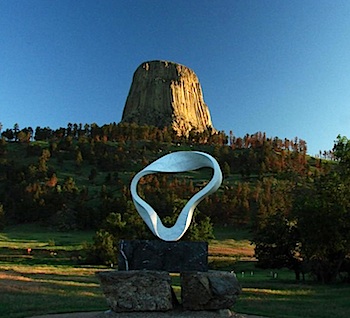
The Circle of Sacred Smoke sculpturewas inspired by the smoke from a peace pipe. Lee Dalton photo.
He had escaped from his desk and was checking to see how a couple of leach field projects at campground restrooms were coming along. We had a wide ranging and philosophical conversation that left me certain that our parks are in good hands with people like him in charge. He told me a bit of his background and mentioned that he, too, is Native American.
It was ironic that I’d just typed the paragraph above and remember too well the days when the only people like him in NPS were maintenance workers who too often lived apart from the rest of us. Things have indeed changed. At least, I hope they have.
I could spend a lot of words describing for readers more of the stories of Devils Tower, but I won’t. If anyone wants to learn more of the spiritual feeling here, or of its discovery, how it was formed, or how the native name for the place was somehow misinterpreted into Devils Tower, or the tale of the first to climb it, or the stuntman who parachuted to its top only to discover he had no way down, or of barfing buzzards – well, if you want to hear those stories, visit the park’s website.
Or much better than that, come and visit for yourself. You’ll be glad you did.

 Support Essential Coverage of Essential Places
Support Essential Coverage of Essential Places







Comments
Lee, thanks for sharing. I really enjoyed reading about your stay.
Lee, very enjoyable read, thank you. I was struck by your comment on the small, local history association in juxtaposition to the corporate model non-profits we are seeing more and more of, ie, Paul Berkowitz, "The Case of the Indian Trader", comes to mind. Paul's book is very good, it truly makes you pause to think about some of the darker sides of large organizations including, unfortunately, the NPS. In any case, thank you for a nice read to start the day.
Like practically everyone of my generation (teenaged in the 70s), I'd always wanted to see Devil's Tower because of its role in the movie Close Encounters of the Third Kind. I finally did in the fall of 1999. I agree with everything you say about the campground -- I was on a three-month cross-country trip at the time, and it was one of the best places I spent the night on the entire trip.
The tower itself is amazing, especially driving up to it from the Interstate. It plays hide-and-seek, appearing and disappearing, then reappearing only much larger, over and over. The trail around it was beautiful with the first real hardwoods of my trip (I was going west to east at the time) just starting to change color against the almost green basalt columns.
And let's not forget the prairie dogs!
Thank you, Lee, for this great piece. I went to Devils Tower last fall for the first time and also was very impressed. It is magical. As I read your line: "Signs along the trails around the tower remind visitors that to many people, this is a sacred place. We are asked not to disturb prayer bundles and cloths left beside the trail by our Native neighbors. To those who leave them, this is a cathedral." I think, to everyone, Devils Tower is a sacred place and a cathedral. I think that feeling of deep, deep reverence for natural areas and the spritis that inhabit them exists in every one of us--but many of us have forgotten how to access it, or have never been given the opportunity. I think it is in our DNA. I think the work now is to help those who have fogotten to remember.
Really enjoyed Lee Dalton's article. I have always wanted to climb it but am too old now. It is great that large vehicles cannot get into the campground and that there is no electricity. One additional benefit would be to have the entrance road re-designed so that tour busses cannot drive it because of low clearance on a hump.
Nothing better than a small, primitive campground with a monolithic view! There are a few others in the NP system such as Echo Park campground in Dinosaur with it's view of Steamboat Rock.
Nice article, Lee, touching on many good issues.
I also appreciate that the visitor center, brochures and signs make the sacred nature of this site an important interpretive theme. It's a good example of what could be done elsewhere.
Lee,
Thank you for writing this article. The family just returned from a vacation that included this park. I want to recommend to your readers the Red Beds Trail hike (approx 2.8 miles) around the Tower. Offers a great perspective (from all angles!) of the tower and surrounding geology.
Again, thanks for the contribution.
Chris